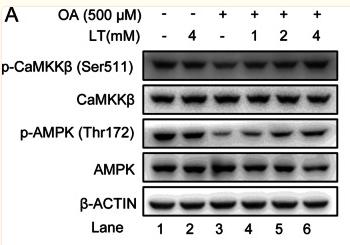| 产品: | 磷酸化 CaMKK2 (Ser511) 抗体 |
| 货号: | AF4487 |
| 描述: | Rabbit polyclonal antibody to Phospho-CaMKK2 (Ser511) |
| 应用: | WB IHC |
| 反应: | Human, Mouse, Rat |
| 预测: | Pig, Bovine, Horse, Sheep, Rabbit, Dog, Chicken |
| 分子量: | 68kDa; 65kD(Calculated). |
| 蛋白号: | Q96RR4 |
| RRID: | AB_2844538 |
产品描述
*The optimal dilutions should be determined by the end user.
*Tips:
WB: 适用于变性蛋白样本的免疫印迹检测. IHC: 适用于组织样本的石蜡(IHC-p)或冰冻(IHC-f)切片样本的免疫组化/荧光检测. IF/ICC: 适用于细胞样本的荧光检测. ELISA(peptide): 适用于抗原肽的ELISA检测.
引用格式: Affinity Biosciences Cat# AF4487, RRID:AB_2844538.
展开/折叠
Calcium/calmodulin dependent protein kinase beta; Calcium/calmodulin dependent protein kinase kinase 2; Calcium/calmodulin dependent protein kinase kinase 2 beta; Calcium/calmodulin dependent protein kinase kinase beta; Calcium/calmodulin-dependent protein kinase kinase 2; Calcium/calmodulin-dependent protein kinase kinase beta; CaM kinase kinase beta; CaM KK beta; CaM-kinase kinase 2; CaM-kinase kinase beta; CaM-KK 2; CaM-KK beta; CaMKK 2; CAMKK; CaMKK beta; CAMKK beta protein; Camkk2; CAMKKB; KKCC2_HUMAN;
抗原和靶标
Ubiquitously expressed with higher levels in the brain. Intermediate levels are detected in spleen, prostate, thyroid and leukocytes. The lowest level is in lung.
- Q96RR4 KKCC2_HUMAN:
- Protein BLAST With
- NCBI/
- ExPASy/
- Uniprot
MSSCVSSQPSSNRAAPQDELGGRGSSSSESQKPCEALRGLSSLSIHLGMESFIVVTECEPGCAVDLGLARDRPLEADGQEVPLDTSGSQARPHLSGRKLSLQERSQGGLAAGGSLDMNGRCICPSLPYSPVSSPQSSPRLPRRPTVESHHVSITGMQDCVQLNQYTLKDEIGKGSYGVVKLAYNENDNTYYAMKVLSKKKLIRQAGFPRRPPPRGTRPAPGGCIQPRGPIEQVYQEIAILKKLDHPNVVKLVEVLDDPNEDHLYMVFELVNQGPVMEVPTLKPLSEDQARFYFQDLIKGIEYLHYQKIIHRDIKPSNLLVGEDGHIKIADFGVSNEFKGSDALLSNTVGTPAFMAPESLSETRKIFSGKALDVWAMGVTLYCFVFGQCPFMDERIMCLHSKIKSQALEFPDQPDIAEDLKDLITRMLDKNPESRIVVPEIKLHPWVTRHGAEPLPSEDENCTLVEVTEEEVENSVKHIPSLATVILVKTMIRKRSFGNPFEGSRREERSLSAPGNLLTKKPTRECESLSELKEARQRRQPPGHRPAPRGGGGSALVRGSPCVESCWAPAPGSPARMHPLRPEEAMEPE
种属预测
score>80的预测可信度较高,可尝试用于WB检测。*预测模型主要基于免疫原序列比对,结果仅作参考,不作为质保凭据。
High(score>80) Medium(80>score>50) Low(score<50) No confidence
翻译修饰 - Q96RR4 作为底物
| Site | PTM Type | Enzyme | Source |
|---|---|---|---|
| S2 | Acetylation | Uniprot | |
| K32 | Ubiquitination | Uniprot | |
| T85 | Phosphorylation | Q96RR4 (CAMKK2) | Uniprot |
| S95 | Phosphorylation | Uniprot | |
| K98 | Ubiquitination | Uniprot | |
| S100 | Phosphorylation | Uniprot | |
| S114 | Phosphorylation | Uniprot | |
| S125 | Phosphorylation | Uniprot | |
| Y128 | Phosphorylation | Uniprot | |
| S129 | Phosphorylation | Q00535 (CDK5) , P49841 (GSK3B) , P49840 (GSK3A) | Uniprot |
| S132 | Phosphorylation | Uniprot | |
| S133 | Phosphorylation | P49840 (GSK3A) , P49841 (GSK3B) , Q00535 (CDK5) | Uniprot |
| S136 | Phosphorylation | Uniprot | |
| S137 | Phosphorylation | P49841 (GSK3B) , P49840 (GSK3A) , Q00535 (CDK5) | Uniprot |
| T145 | Phosphorylation | Uniprot | |
| S148 | Phosphorylation | Uniprot | |
| K173 | Ubiquitination | Uniprot | |
| Y183 | Phosphorylation | Uniprot | |
| Y190 | Phosphorylation | Uniprot | |
| K194 | Ubiquitination | Uniprot | |
| Y234 | Phosphorylation | Uniprot | |
| K241 | Ubiquitination | Uniprot | |
| K242 | Ubiquitination | Uniprot | |
| K307 | Ubiquitination | Uniprot | |
| K314 | Ubiquitination | Uniprot | |
| K327 | Ubiquitination | Uniprot | |
| T350 | Phosphorylation | Uniprot | |
| K403 | Ubiquitination | Uniprot | |
| K420 | Ubiquitination | Uniprot | |
| K429 | Ubiquitination | Uniprot | |
| K441 | Ubiquitination | Uniprot | |
| T483 | Phosphorylation | Q96RR4 (CAMKK2) | Uniprot |
| K488 | Ubiquitination | Uniprot | |
| S495 | Phosphorylation | Uniprot | |
| S509 | Phosphorylation | Uniprot | |
| S511 | Phosphorylation | P53355 (DAPK1) | Uniprot |
| S572 | Phosphorylation | Uniprot |
翻译修饰 - Q96RR4 作为激酶
研究背景
Calcium/calmodulin-dependent protein kinase belonging to a proposed calcium-triggered signaling cascade involved in a number of cellular processes. Isoform 1, isoform 2 and isoform 3 phosphorylate CAMK1 and CAMK4. Isoform 3 phosphorylates CAMK1D. Isoform 4, isoform 5 and isoform 6 lacking part of the calmodulin-binding domain are inactive. Efficiently phosphorylates 5'-AMP-activated protein kinase (AMPK) trimer, including that consisting of PRKAA1, PRKAB1 and PRKAG1. This phosphorylation is stimulated in response to Ca(2+) signals (By similarity). Seems to be involved in hippocampal activation of CREB1 (By similarity). May play a role in neurite growth. Isoform 3 may promote neurite elongation, while isoform 1 may promoter neurite branching.
Autophosphorylated and phosphorylated by PKA. Each isoform may show a different pattern of phosphorylation.
Nucleus. Cytoplasm. Cell projection>Neuron projection.
Note: Predominantly nuclear in unstimulated cells, relocalizes into cytoplasm and neurites after forskolin induction.
Ubiquitously expressed with higher levels in the brain. Intermediate levels are detected in spleen, prostate, thyroid and leukocytes. The lowest level is in lung.
Interacts with calmodulin.
The autoinhibitory domain overlaps with the calmodulin binding region and may be involved in intrasteric autoinhibition.
The RP domain (arginine/proline-rich) is involved in the recognition of CAMKI and CAMK4 as substrates.
Belongs to the protein kinase superfamily. Ser/Thr protein kinase family.
研究领域
· Cellular Processes > Transport and catabolism > Autophagy - animal. (View pathway)
· Environmental Information Processing > Signal transduction > AMPK signaling pathway. (View pathway)
· Human Diseases > Substance dependence > Alcoholism.
· Organismal Systems > Aging > Longevity regulating pathway. (View pathway)
· Organismal Systems > Endocrine system > Adipocytokine signaling pathway.
· Organismal Systems > Endocrine system > Oxytocin signaling pathway.
文献引用
Application: WB Species: Mice Sample: CRC cells
Application: WB Species: mouse Sample: livers
Application: WB Species: Human Sample: HepG2 cells
Application: WB Species: Rat Sample: myocardial tissue
限制条款
产品的规格、报价、验证数据请以官网为准,官网链接:www.affbiotech.com | www.affbiotech.cn(简体中文)| www.affbiotech.jp(日本語)产品的数据信息为Affinity所有,未经授权不得收集Affinity官网数据或资料用于商业用途,对抄袭产品数据的行为我们将保留诉诸法律的权利。
产品相关数据会因产品批次、产品检测情况随时调整,如您已订购该产品,请以订购时随货说明书为准,否则请以官网内容为准,官网内容有改动时恕不另行通知。
Affinity保证所销售产品均经过严格质量检测。如您购买的商品在规定时间内出现问题需要售后时,请您在Affinity官方渠道提交售后申请。产品仅供科学研究使用。不用于诊断和治疗。
产品未经授权不得转售。
Affinity Biosciences将不会对在使用我们的产品时可能发生的专利侵权或其他侵权行为负责。Affinity Biosciences, Affinity Biosciences标志和所有其他商标所有权归Affinity Biosciences LTD.




